If you are interested in bringing a Leopard Gecko into your home, one of the first questions you might ask is, “how much does one cost?” People frequently believe these charming reptiles can be purchased for very little money, which is not the case.
A leopard gecko may be purchased at your neighborhood pet store chain for as little as $30 to $50, some leopard gecko specimens can sell for more than $2,500, some way more than that.
There are a lot of different aspects that go into determining how much a Leopard Gecko costs. There is a correlation between color, pattern, age, genetics, and breeder.
Before purchasing a leopard gecko, it is essential to understand the factors that influence its pricing. You will be well-prepared and aware of what constitutes a reasonable sum if you proceed in this manner.
This article will provide a comprehensive analysis of all you need to know about the cost of Leopard Geckos. We provide an answer to the question, “How much is a Leopard Gecko?” and also discuss some exciting price information and the costs associated with ownership along the road.
How Much Is a Leopard Gecko?
One thing about buying a leopard gecko is you can spend as little as $30 or as much as you want. If you buy from a pet store, the price is likely lower than buying from a private breeder. Check out this table below on the cost of geckos based on breeder and age.
| Breeder | Hatchlings | Hatchlings Average | Adults | Adults average |
| Online | $30 – 75 | $45 | $50 – 100 | $60 |
| Pet Store | $20 – 70 | $30 | $40 – 100 | $50 |
| Private breeder | $50 – 150 | $75 | $60 – 200 | $75 |
Breeder Price
If you’re looking for a leopard gecko that stands out from the rest, you’ll want to look into purchasing one from a reputable breeder. These breeders typically have the widest variety of leopard geckos available, as well as knowledgeable individuals who can provide you with detailed information on the genetics and lineage of that species.
In addition to guaranteeing the health of their hatchlings for a set period of time, some breeders also offer warranties and support for the duration of the animal’s life. If you purchase your leopard gecko from a responsible breeder, you can be assured that it will be healthy and well-adjusted.
However, if you go with a private breeder instead, keep in mind that they may not have as many pets available for adoption and may operate on a smaller scale.
This means that their leopard geckos may be more difficult to find or have more limited availability. Either way, buying from an ethical breeder is always worth it because they maintain high standards in both their breeding practices and customer service.
When it comes to purchasing a leopard gecko, there are a few things to consider. The first thing is price; standard Leopard Geckos may typically be purchased from reputable breeders for the price of $60-$100 per reptile (depending on size). Breeders usually have the largest variety available, including fascinating forms, colors, and lineages.
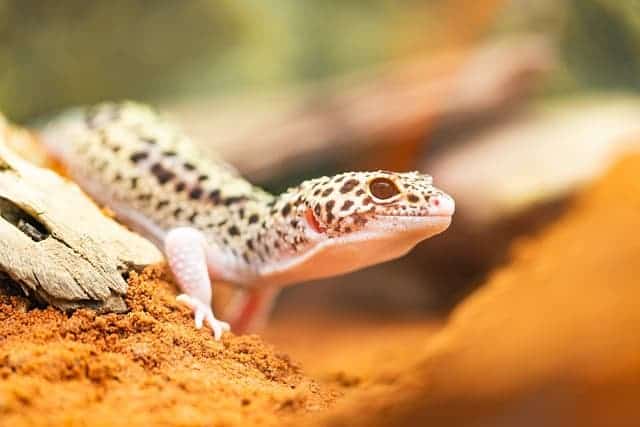
Pet Store Price
Unlike those from private breeders, which can be quite pricey, leopard geckos typically cost around $50 at pet stores. This price tag is certainly modest, but it does not automatically mean you should purchase one immediately.
It’s important to understand that there are times when pet stores purchase their leopard geckos in large quantities from breeders operating “reptile mills.”
These unethical businesses frequently sell unhealthy or injured reptiles and keep their animals in deplorable conditions. Not only will purchasing a pet from a breeder who lacks ethical standards result in higher veterinary care costs down the road, but the animal you end up with may not even be healthy enough to live.
In order to get a leopard gecko that is healthy and well-behaved, it’s recommended that you look for a responsible breeder. There is very little information available on genetics or bloodlines at pet stores – what is available is typically ordinary or fancy leopard geckos.
As a result, if you want to take part in the hobby seriously, it’s important to learn about the genetics of your gecko before making your purchase.
Leopard geckos can suffer from a neurological condition known as Enigma Syndrome. Having knowledge about this specific morph can be essential for keeping your gecko healthy and happy.
Finally, although many pet retailers promise health guarantees or support services, this almost always indicates the level of confidence these businesses have in the quality of their leopard geckos.
Escape Centers
There are many local rescue organizations that will take leopard geckos from prior owners who have either lost interest in them or are unable to care for them anymore. By paying an adoption fee, you will be able to purchase a leopard gecko along with its enclosure and you may be lucky to receive other basic equipment. The charge for the gecko and its stuff is often approximately 50$, which is a great deal considering it covers both.
The cost of adoption will change from one rescue institution to the next that you get in touch with. This is a great deal considering it covers both the purchase price of the leopard gecko as well as a part of the necessary supplies needed to care for him or her properly.
Friends or People Who Have Lost Interest
A friend may have purchased a leopard gecko and ended up losing interest. They may decide to dispose it at a throw away price or give it away for free. If you are lucky enough you can find such a deal from the local vet or in local pet advertisements.
Factors That Affect the Price of a Leopard Gecko
The price of a leopard gecko depends on various factors including:
1. Morph
Many factors affect the price of a leopard gecko, but the morph is undoubtedly one of the major determinants. A leopard gecko is said to have a certain morph if it has a distinct coloration or pattern.
Some variants are significantly more challenging to breed than others, and the price will typically reflect this difficulty level.
For instance, wild-type leopard geckos are those that have been raised to have the same coloration as wild leopard geckos.
They are one of the least expensive morphs owing to the ease with which they can be bred. Keepers who are just starting out have a strong preference for wild-type or standard leopard geckos. Other variants require a greater skill level to breed and are significantly more expensive.
Here are the common morphs and what you can expect to pay:
Fancy – The term “fancy” gecko is used by many pet businesses to refer to any gecko that is not of the typical wild form. They typically cost between $50 and $70, which is slightly more than the going rate for regular geckos. Despite its name, the Leopard Gecko morph is not very fancy looking and does not have elaborate patterns like some of the more expensive morphs.
Tremper Albino – This is a unique morph of albinos distinguished from others by having brownish markings and light-colored eyes. A standard tremper albino can be purchased for about $50 and $125. Some of the hybrid morphs, such as the Tremper sunglow or the Giant Tremper, will have a price tag far higher than $200.
Orange – Orange leopard geckos are some of the most exciting and striking geckos on the market, going for between $80 to $150. They come in a range of colors, from tangerine to yellow and everything in between. While they’re usually referred to as orange, some breeders have used the tangerine gene to create intriguing morphs, such as sunglows, that can sell for up to $400.
Murphy’s Patternless – Another popular morph named after its distinct pattern on the body. It has little to no pattern and costs about $50 to $70.
Rainwater Albino – Rainwater albinos are one of the more unusual types of albino morphs. Typically, albinos have eyes that are noticeably lighter in color than their surrounding skin. However, with rainwater albinos, the color difference is even more pronounced. The eyes of this variety are typically a darker hue than other parts of their body. Their price can range from $200 to $400.
Eclipse – Eclipse geckos are a type of gecko with completely black eyes. This recessive gene only influences eye color, which results in their eyes being completely black. In order to create morphs such as super snows, Tremper eclipses, and blizzards, recessive is paired with other genes. An eclipse can typically be purchased for between $75 and $125.
Black Night – This is arguably the most expensive of all leopard gecko morphs, with a price tag between $400 to $3000! You are more likely to pay over $2000 for the very dark ones. For those not completely black, expect to pay between $400 to $1000.
Leopard Gecko Price Table
| Morph | Price |
| Standard or Common | $30 |
| Fancy | $50 |
| Pattern less | $75 |
| Blizzard | $80 |
| Eclipse | $100 |
| Tangerine | $200 |
| Tremper | $250 |
| Giant | $175 |
| Lemon Frost | $350 |
| Black Pearl | $300 |
2. Breeder’s Work
In addition to the morph, the breeder can have an effect on the price. Certain breeders will have unique lineages, and these leopard gecko breeders are well-known for their animals’ brilliant colors, calm temperaments, and pristine health.
This explains why different breeders charge different amounts for leopard geckos. Getting a leopard gecko from a private breeder with a good reputation in the industry is always advisable. It may include breeders in your area, breeders online, or breeders at an expo in your neighborhood.
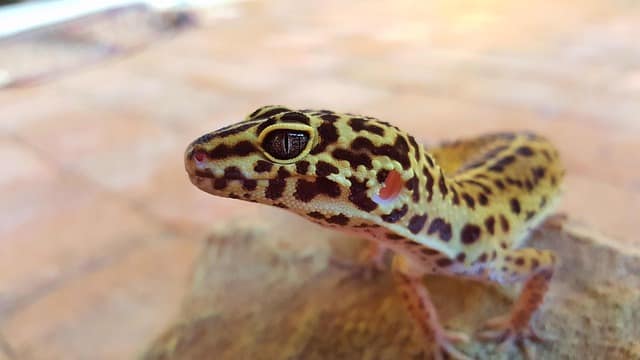
3. Health Guarantees
Several reputable breeders offer guarantees on the gecko’s health and that they arrive at your house in pristine condition. Precisely, you are almost certain to be content with your purchase.
As a result, the prices at private breeders are typically higher than those at pet retailers, but the quality and health of their leopard geckos is frequently much improved.
Hatchlings sold at pet stores may be of poor quality and unhealthy, even though they may be initially more affordable. It is vital to investigate the credentials of any breeder you are considering purchasing a leopard gecko from before making a purchase.
4. Age
Age can be a major factor when it comes to the cost of leopard geckos. A young, ungrown leopard gecko will typically cost less than an older one since they are not yet fully grown. However, as the gecko ages, its price will likely go up.
A 2-year-old leopard gecko might cost more than a six-month-old one because it is already sexually mature for breeding and past the demanding juvenile stage.
5. State
Some states, like Ohio and Florida, have numerous well-known reptile expos and a significant concentration of breeders who specialize in raising reptiles. Because there is a healthy market in these states, the price of a leopard gecko will typically be lower.
Leopard geckos from other states, particularly those with extremely low average temperatures or in which there are no specialized breeders, typically sell for a higher price. For instance, Alaska has a relatively low breeder density, yet because of the state’s frigid environment, the cost of carrying goods to Alaska is significantly higher.
The warmer months of the year are necessary for shipping goods to states at higher latitudes. Reputable breeders will not release a reptile into the wild if the temperature is forecast to be too low.
What It Takes To Own A Leopard Gecko – Cost and the Things You’ll Need
In addition to the gecko itself, you also want to consider how much it costs to own. The basic needs are a cage, ideal temperature, lighting, and other accessories.
We provide a complete breakdown of the costs of each item you will need. Note that the price can fluctuate depending on the products you choose. Check out the costs of owning a leopard gecko:
· Habitat/Cage
A leopard gecko’s enclosure needs at least a gallon in size, but most owners choose to get a tank with more than that capacity. In terms of height, there is no requirement for anything higher than one foot.
A tank that satisfies these standards does not have to be purchased at an exorbitant price. In most cases, the cost of a 10-gallon tank with a mesh cover won’t exceed $50. The price of a 20-gallon tank with a mesh top will be slightly more, but it should still be less than $100.
When purchasing your leopard gecko’s enclosure, make sure that it has a mesh top so that you can observe your gecko and ensure its safety. Additionally, always purchase a tank with a lid to keep your gecko safe from other animals and predators.
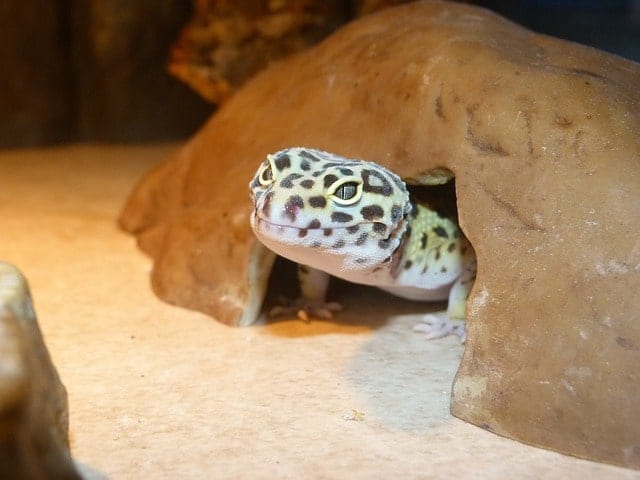
· Heat Lamp
Geckos, specifically leopard geckos, need a warm environment to live in. In the wild, leopard geckos will bask in the sun to generate heat. This means that their enclosure must include a way for them to generate heat themselves. The two most common ways to provide this heat are a heat lamp or a heat mat.
Heat lamps come in many different wattage levels and light outputs, and they vary significantly in price. A good quality light with watts for about $10 a piece is adequate for most leopard gecko enclosures. Be sure to select a light that is not too powerful, as it can cause damage if used incorrectly.
Alternatively, you can purchase a mat that will cover a decent amount of space and be powerful enough to penetrate the tank and the substrate. Prices range from around $15 and $25. Both options provide an efficient way for leopard geckos to generate their own heat, but each has its own advantages and disadvantages.
· Fluorescent Light
When owning a leopard gecko, it is necessary to provide them with an efficient heat source. Two main types of heat sources can be used for this – a heat lamp or a heat mat. Heat lamps come in low and high-wattage options, offering a wide range of intensities to choose from.
If you put one side of the enclosure for the leopard gecko on a higher wattage side, they will be able to warm up faster. It is important to note that too much light emitted from a heat lamp can cause damage to their eyes. A good quality light will cost around $10 apiece.
If you prefer not to use a lamp, buy a mat that will create warmth underneath the enclosure and cover enough space for your leopard gecko to relax. A mat typically costs between $10 and $20. Be sure to budget this into your expenses when purchasing your pet because these items tend not to last long.
· Rocks & Other Décor
The possibilities are endless when it’s time to decorate your leopard gecko’s environment. You could put in rocks from all over the world, add bark from different trees, or install some climbing structures for your leopard gecko to play on.
You don’t even need to purchase decorations exclusively marketed towards reptiles; anything that can provide shelter and add aesthetic value can be used.
Whether you go with a more traditional setup or something more creative, using environmental decorations in conjunction with their “hides” will give your leopard gecko the perfect home they deserve.
· Thermometer/Hygrometer
Both the temperature and humidity of your gecko’s tank need to be monitored, so you’ll need both a thermometer and a hygrometer, respectively. Fortunately, some products combine the two into a single unit. Such a tool typically only costs around $15 and is absolutely invaluable.
Your leopard gecko’s enclosure should have a temperature gradient. This means that one side of their enclosure should be around 70°F to 75°F, while the warmer side is right around 90°F. As for humidity, a level of between 20% and 40% should always be maintained, especially when your gecko is shedding. Keeping track of the temperature and humidity is a vital part of leopard gecko ownership
· Food and Water Dishes
A leopard gecko needs a bowl to hold its food and liquids. You can get a regular ceramic or rock dish with a more natural appearance to hold your water. Please make sure the dish is cleaned regularly and that there is a steady supply of water appropriate for reptiles.
It is crucial to provide your gecko with a feeding dish that can adequately contain live food, such as mealworms if you plan on giving them to your leopard gecko. The total cost of these dishes shouldn’t be more than $20, and with proper maintenance and care, they should last a lifetime without any problems.
· Dry Hide
Dry hides are essential for leopard geckos to have for them to be able to feel secure and at ease in their surroundings. They provide a calm environment in the cooler part of the tank and a warm environment under the heat lamp in the warmer part of the tank, making it more interesting for your gecko.
You can purchase a dry hide or make one on your own with some rocks and materials. The most you will ever have to pay for a leopard gecko hide is $30.
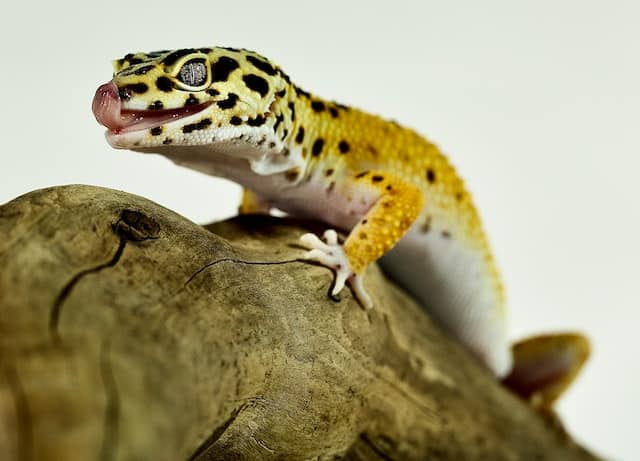
· Humid Hide
Unlike a dry hide, you have to maintain a humid environment in a humid hide. Your gecko will find this set a pleasant place to unwind and, more importantly, to shed its skin.
As a result of this, it is essential that you consistently offer your gecko a hide that is kept at an appropriate humidity level. You may make this humid hide from scratch, just like the dry one.
Using secure Tupperware containers stuffed with moss will do the trick just as well, and the total cost will be less than $10. However, several wonderful pre-made humid hides can be purchased for less than $20.
The Cost of Consumables
Consumables form every day or regular costs of leopard gecko ownership. This includes things that will be used and replaced, such as substrate food and moss. Be sure to choose the best quality of these items as they impact your pet’s health.
· Food
Leopard geckos are insectivores, which means that the only food they consume is insects. Because of this, there are not an excessive number of food options available, which makes mealtime somewhat less stressful.
Crickets, mealworms, super worms, and dubia roaches are the four types of prey most frequently consumed by leopard geckos.
You should budget anything from $60 to 120 each year to cover the cost of the food for your leopard gecko. You may also have to pay for gut-loading food, which is an additional expense. It involves providing a supplement to the feeder insects approximately twenty-four hours before feeding them to your gecko.
Because of this, they are significantly more nutritious for your gecko, providing you with a greater value for your money.
· Substrate
Several substrates can be used in an enclosure, but a reptile carpet is the most common. It’s placed at the bottom of the enclosure and can be reused and cleaned, making it a cost-effective choice over the long term. It could cost about $15 for this type of substrate.
Another option is using a loose substrate such as coconut fiber. It is simple to replace and has a relatively unaltered appearance, but you will need to exercise caution due to the dust present. Because leopard geckos originate in a dry region, the environment in which they live must likewise be dry for them to thrive. A gecko’s respiratory system may get inflamed if the substrate is dry and dusty.
Because leopard geckos do not require a deep substrate, the cost of using coconut fiber will be approximately $20 per year. You must steer clear of fine substrates such as sand and gravel. Although it is inexpensive, there is a risk of obstruction if consumed.
· Sphagnum Moss
One of the great benefits of adding sphagnum moss to your leopard gecko’s enclosure is that it can maintain moisture for longer than other types of moss. This moss requires less maintenance, and it resists decomposition fairly well. Sphagnum moss will be utilized the most within the humid hide that your gecko has, and it should be wet consistently.
If you discover that the moss is beginning to decompose, you must replace it with new moss. This part of your gecko’s enclosure costs only approximately $10 per year, which means that it won’t make much of a dent in the overall cost of ownership.
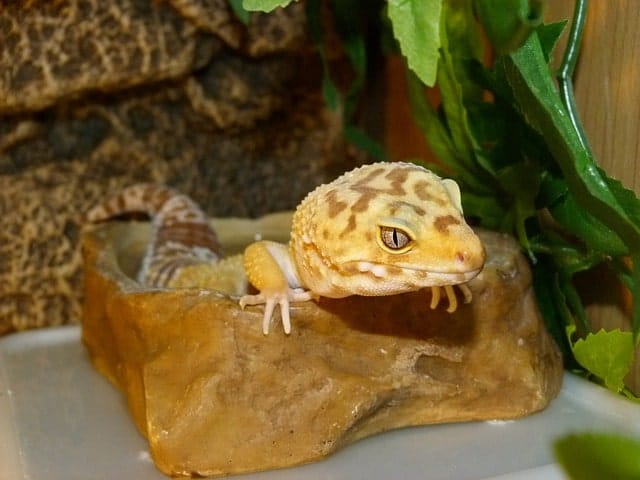
Medical Costs You May Incur to Keep Your Leopard Gecko Healthy
Even after taking excellent care of your leopard gecko, there’s a chance they might run into unexpected health problems. Therefore, it’s important to stay observant and to be ready when a problem occurs.
· Parasites/ Illness Medication
The average cost to treat a leopard gecko for common illnesses and parasites is around $50-$100. However, this number can fluctuate depending on the specific ailment, the location of treatment, and if special equipment or medications are required. There is also the potential for additional costs if your leopard gecko needs surgery, boarding during its stay at the vet, or rehabilitation afterward.
While owning a leopard gecko has some associated costs, these expenses tend to be relatively low compared to other pet options. Furthermore, by taking care of your leopard gecko and monitoring its health closely, you can minimize these expenses to an almost negligible level.
· Random Medical Needs
Leopard geckos can get randomly sick, even if you’re a vigilant owner. It’s essential to learn about what can cause common issues so that you can work to avoid those.
Once you know what most commonly affects leopard geckos and take steps to prevent those problems, the chances of your gecko living a long and healthy life rise greatly.
Many random medical conditions can be fixed at a low cost or nothing. Most over-the-counter medication will cost at least $10, but you can expect to pay more for severe occurrences requiring surgery.
Conclusion
In general, leopard geckos are reasonably priced pets to own and care for. The initial expenses for keeping a leopard gecko are relatively expensive, but subsequent years’ expenses are far more affordable.
Your initial prices, as well as your annual costs, will be slightly greater if you choose to make the investment in supplies of a higher grade, but this is something that is strongly suggested.
Here’s a summary of the costs involved:
| Product/Service | Initial Cost | Yearly Cost |
| Enclosure | $100 – $300 | |
| Heat Lamp | $10 – $30 | |
| Fluorescent light | $20 – $50 | |
| Rocks & other decor | $30 – $100 | |
| Thermometer/hygrometer | $10 – $20 | |
| Food/Water bowls | $15 | |
| Dry Hide | $15 | |
| Humid Hide | $15 | |
| Food | $60 – $120 | |
| Substrate | $10 – $20 | |
| Sphagnum Moss | $10 – $20 | |
| Disease/Parasite meds | $0 – $50 | |
| Random medical needs | $0 -$50 |